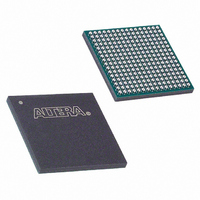EPM2210F256C4 Altera, EPM2210F256C4 Datasheet - Page 43

EPM2210F256C4
Manufacturer Part Number
EPM2210F256C4
Description
IC MAX II CPLD 2210 LE 256-FBGA
Manufacturer
Altera
Series
MAX® IIr
Specifications of EPM2210F256C4
Programmable Type
In System Programmable
Delay Time Tpd(1) Max
7.0ns
Voltage Supply - Internal
2.5V, 3.3V
Number Of Logic Elements/blocks
2210
Number Of Macrocells
1700
Number Of I /o
204
Operating Temperature
0°C ~ 85°C
Mounting Type
Surface Mount
Package / Case
256-FBGA
Voltage
2.5V, 3.3V
Memory Type
FLASH
Number Of Logic Elements/cells
2210
Family Name
MAX II
# Macrocells
1700
Frequency (max)
2.3148GHz
Propagation Delay Time
9.1ns
Number Of Logic Blocks/elements
221
# I/os (max)
204
Operating Supply Voltage (typ)
2.5/3.3V
In System Programmable
Yes
Operating Supply Voltage (min)
2.375V
Operating Supply Voltage (max)
3.6V
Operating Temp Range
0C to 85C
Operating Temperature Classification
Commercial
Mounting
Surface Mount
Pin Count
256
Package Type
FBGA
Lead Free Status / RoHS Status
Contains lead / RoHS non-compliant
Features
-
Lead Free Status / Rohs Status
Not Compliant
Other names
544-1340
EPM2210F256C4
EPM2210F256C4
Available stocks
Company
Part Number
Manufacturer
Quantity
Price
Company:
Part Number:
EPM2210F256C4
Manufacturer:
ALTERA
Quantity:
1 758
Part Number:
EPM2210F256C4
Manufacturer:
ALTERA/阿尔特拉
Quantity:
20 000
Company:
Part Number:
EPM2210F256C4N
Manufacturer:
ALTERA
Quantity:
24
Company:
Part Number:
EPM2210F256C4N
Manufacturer:
ALTERA
Quantity:
6
Company:
Part Number:
EPM2210F256C4N
Manufacturer:
ALTERA
Quantity:
745
Part Number:
EPM2210F256C4N
Manufacturer:
ALTERA/阿尔特拉
Quantity:
20 000
Introduction
IEEE Std. 1149.1 (JTAG) Boundary-Scan Support
Table 3–1. MAX II JTAG Instructions (Part 1 of 2)
© October 2008 Altera Corporation
MII51003-1.6
SAMPLE/PRELOAD
EXTEST
BYPASS
USERCODE
IDCODE
HIGHZ
JTAG Instruction
(1)
(1)
This chapter discusses how to use the IEEE Standard 1149.1 Boundary-Scan Test (BST)
circuitry in MAX II devices and includes the following sections:
■
■
All MAX
circuitry that complies with the IEEE Std. 1149.1-2001 specification. JTAG boundary-
scan testing can only be performed at any time after V
been fully powered and a t
use the JTAG port for in-system programming together with either the Quartus
software or hardware using Programming Object Files (.pof), JamTM Standard Test
and Programming Language (STAPL) Files (.jam), or Jam Byte-Code Files (.jbc).
The JTAG pins support 1.5-V, 1.8-V, 2.5-V, or 3.3-V I/O standards. The supported
voltage level and standard are determined by the V
The dedicated JTAG pins reside in Bank 1 of all MAX II devices.
MAX II devices support the JTAG instructions shown in
“IEEE Std. 1149.1 (JTAG) Boundary-Scan Support” on page 3–1
“In System Programmability” on page 3–4
00 0000 0101
00 0000 1111
11 1111 1111
00 0000 0111
00 0000 0110
00 0000 1011
Instruction Code
®
II devices provide Joint Test Action Group (JTAG) boundary-scan test (BST)
3. JTAG and In-System Programmability
CONFIG
Allows a snapshot of signals at the device pins to be captured and
examined during normal device operation, and permits an initial data
pattern to be output at the device pins.
Allows the external circuitry and board-level interconnects to be
tested by forcing a test pattern at the output pins and capturing test
results at the input pins.
Places the 1-bit bypass register between the TDI and TDO pins,
which allows the BST data to pass synchronously through selected
devices to adjacent devices during normal device operation.
Selects the 32-bit USERCODE register and places it between the
TDI and TDO pins, allowing the USERCODE to be serially shifted
out of TDO. This register defaults to all 1’s if not specified in the
Quartus II software.
Selects the IDCODE register and places it between TDI and TDO,
allowing the IDCODE to be serially shifted out of TDO.
Places the 1-bit bypass register between the TDI and TDO pins,
which allows the boundary scan test data to pass synchronously
through selected devices to adjacent devices during normal device
operation, while tri-stating all of the I/O pins.
amount of time has passed. MAX II devices can also
Description
CCIO
CCINT
of the bank where it resides.
Table
and all V
3–1.
CCIO
MAX II Device Handbook
banks have
®
II














